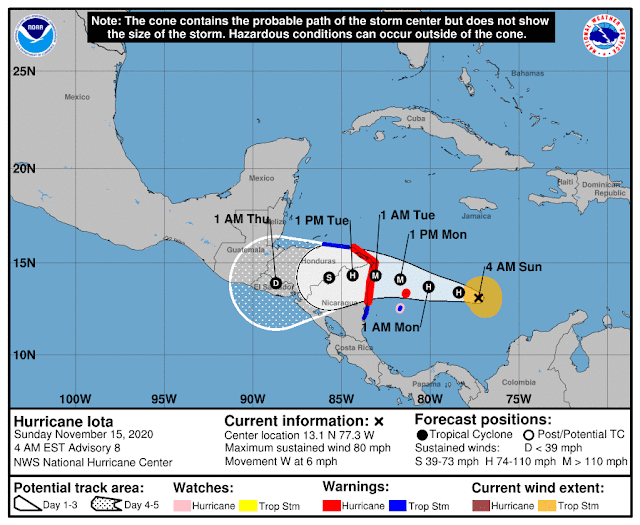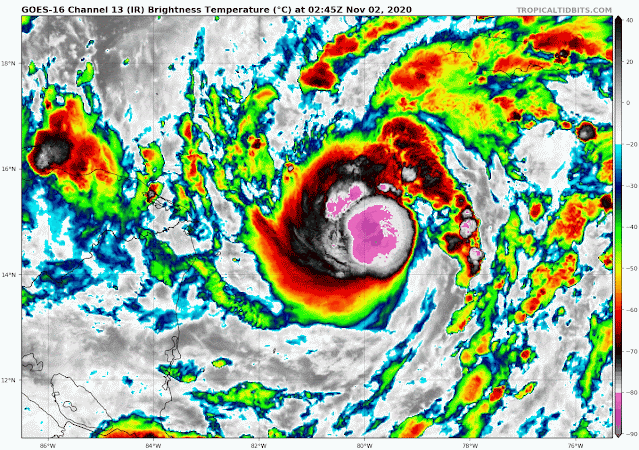The 2020 Atlantic hurricane season officially ends today, and it has certainly been one for the record books. As of today, there were 30 named storms, 13 of which became hurricanes, and 6 of those became major hurricanes (Category 3+ on the Saffir-Simpson Scale). For context, the average of those same quantities over the past fifty years is 12.2, 6.3, and 2.5.
This also marks the end of my 25th year writing these updates on tropical Atlantic activity. During that time, I have written approximately 1305 posts spanning 412 tropical cyclones, 190 hurricanes, 86 major hurricanes, and close to 50 retired storm names (2019 and 2020 TBD). I was honored to have been invited to write for the New York Times hurricane blog for four years, and then for the Washington Post's Capital Weather Gang from to 2012 to present.
The previous record number of named storms was 28, set in 2005. And not only did 2020 beat that record, it did so quickly. With the exception of the 1st, 2nd, and 4th storms, the remaining 27 were all the earliest formation dates on record!
A common metric used to describe overall activity is the Accumulated Cyclone Energy, or ACE. It is independent of the number of storms and their tracks, but essentially measures a cumulative intensity and duration of all storms. 14 of the 30 named storms were around for three days or less, and coincidentally 14 of the 30 never got stronger than a mid-range (50-knot) tropical storm. So despite the large number of named storms, 17 of them were fairly short-lived and/or weak -- a handicap for generating a lot of ACE. The 2020 season is in 10th place in terms of ACE, and is at 178% of an average season.
For the sixth year in a row, there was pre-season activity. 2020 came out of the gate strong, with Arthur and Bertha forming during May. Then Cristobal formed on the first day of the official season and it never let up after that. A record ten named storms formed during September. The regular list of 21 names was exhausted by mid-September, and the Greek alphabet was utilized for only the second time ever... beginning with Alpha on September 18 (which strangely enough was Portugal's first named storm landfall). As of today, nine letters of the Greek alphabet have been used.
Two things stand out to me in that track map at the beginning of the post. The first is that only one hurricane (Teddy) existed in the tropics between the central Caribbean and Africa. That is not a trait we tend to think of with very active seasons. The second is the high concentration of tracks in the western Caribbean and Gulf of Mexico. I'm not exactly sure what caused this pattern, but some large-scale atmospheric/oceanic forcing was at work. I don't think the weak La Nina alone explains this. Unfortunately, storms in the western Caribbean Sea and Gulf of Mexico almost always make landfall... there's no way out.
A record-breaking twelve named storms made landfall in the contiguous U.S., easily surpassing the previous record of nine set in 1916. Five of those twelve hit Louisiana alone, and three of those five were hurricanes (Laura, Delta, and Zeta). The Yucatan peninsula had three landfalls, including two hurricanes (Delta and Zeta), and then there's Nicaragua. Two Category 4 hurricanes made landfall at the same location (technically seven miles apart) just two weeks apart: Eta and Iota. Iota, a mid-November storm, became the season's strongest storm, rapidly intensifying to reach Category 5 status. Not only was it the season's only Category 5 hurricane, it made 2020 the fifth consecutive year to have a Category 5 hurricane. November 2020 was the only November to have two major hurricanes.
 |
| Tracks of the landfalling tropical storms and hurricanes in the western Caribbean Sea and Gulf of Mexico during 2020. |
Although the final reanalysis of the season won't be completed for a few more months, the preliminary track and intensity verification of forecasts made by the National Hurricane Center are shown below. To arrive at these, all 24-hour forecasts are evaluated against all observed values at that time, and so on out to 120 hours. The average error over the prior five seasons is included for reference. Overall, track forecasts were extremely close to the average out to four days, then slightly higher at five days (Paulette was a big reason for that drift at five days). Intensity forecasts were near-average out to two days then better than average for three, four, and five-day forecasts.
Of course, the bounds of the official hurricane season (June 1 through November 30) are arbitrary, and nature could still throw in more storms during December. Years with post-season storms include 2013, 2007, 2005, 2003, 1984, 1975, etc. so it's certainly not unheard of; in fact, there have been sixteen known named storms to form during December since 1851, five of which became hurricanes. The next two names would be Kappa and Lambda. Otherwise, the 2021 regular list will kick off with Ana and Bill.
 |
| Tracks of the 16 known storms that became tropical storms or hurricanes during December since 1851. |























 So far, forecasts of Eta's evolution over the western Caribbean and into Cuba have been very good. The center crossed over central Cuba on Sunday morning, and it's back over water -- roughly 220 miles south-southeast of Miami as of 10am on Sunday. It has intensified to a strong tropical storm, and it's forecast to attain Category 1 hurricane status as it passes between Florida and Cuba.
So far, forecasts of Eta's evolution over the western Caribbean and into Cuba have been very good. The center crossed over central Cuba on Sunday morning, and it's back over water -- roughly 220 miles south-southeast of Miami as of 10am on Sunday. It has intensified to a strong tropical storm, and it's forecast to attain Category 1 hurricane status as it passes between Florida and Cuba.






 Since Monday morning's update, Eta did indeed continue to rapidly intensify, reaching an upper-end Category 4 hurricane that slowly drifted in to make landfall in Nicaragua on Tuesday afternoon. It has expectedly weakened significantly over the mountainous terrain of Nicaragua and Honduras and is now a very disorganized tropical depression centered over Honduras. The question is: what happens next?!
Since Monday morning's update, Eta did indeed continue to rapidly intensify, reaching an upper-end Category 4 hurricane that slowly drifted in to make landfall in Nicaragua on Tuesday afternoon. It has expectedly weakened significantly over the mountainous terrain of Nicaragua and Honduras and is now a very disorganized tropical depression centered over Honduras. The question is: what happens next?!




 Since my previous update on Friday morning, the wave in the eastern Caribbean was upgraded to Tropical Depression 29 on Saturday afternoon, then to Tropical Storm Eta on Saturday night. This made it the season's 28th named storm which ties the 2005 record. Then, on Monday morning, it was upgraded again to Hurricane Eta, the 12th hurricane of the season. It is less than a day from making landfall on Nicaragua.
Since my previous update on Friday morning, the wave in the eastern Caribbean was upgraded to Tropical Depression 29 on Saturday afternoon, then to Tropical Storm Eta on Saturday night. This made it the season's 28th named storm which ties the 2005 record. Then, on Monday morning, it was upgraded again to Hurricane Eta, the 12th hurricane of the season. It is less than a day from making landfall on Nicaragua.











